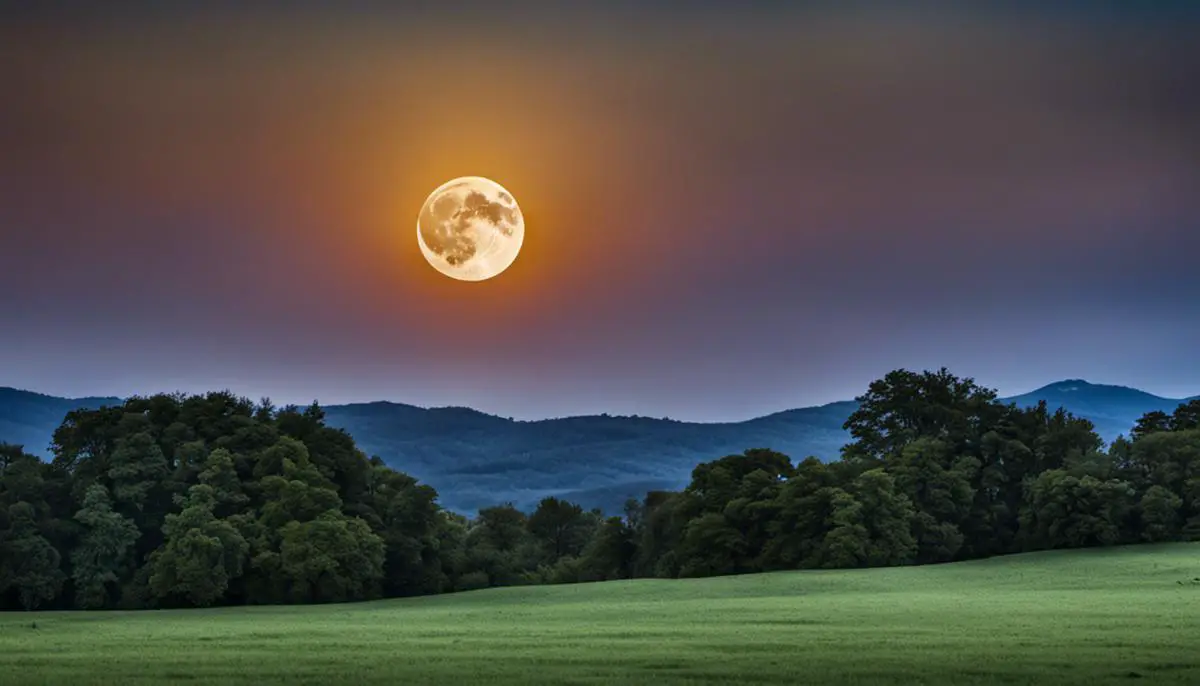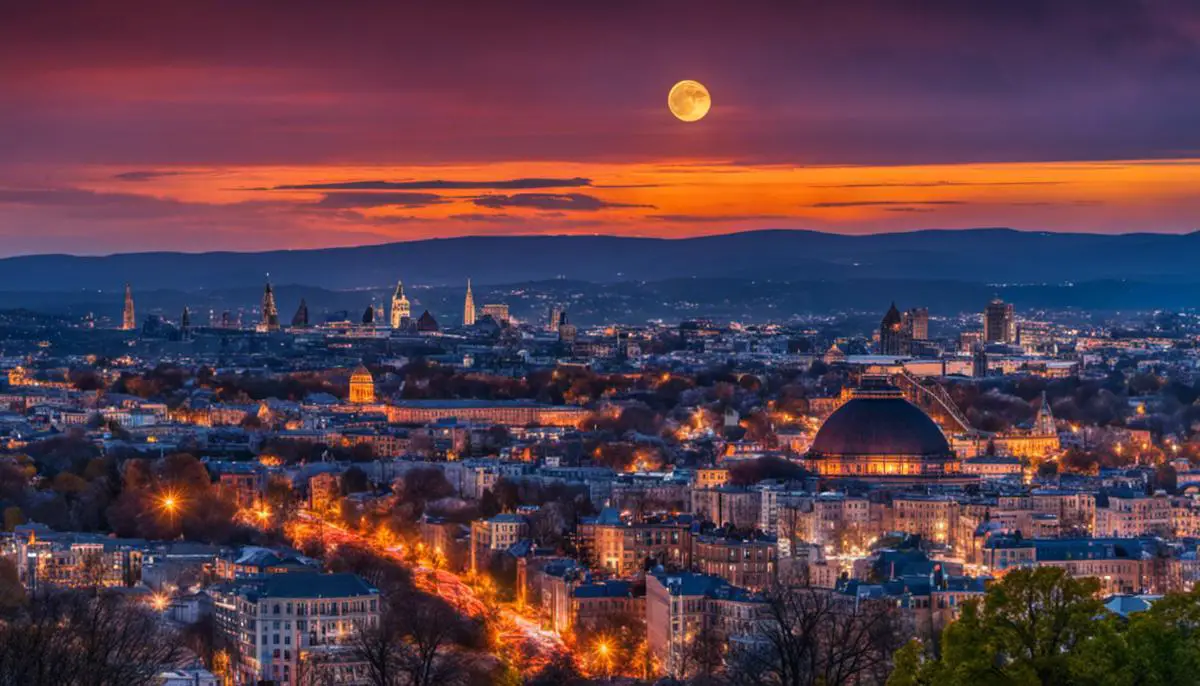Our night sky has labored as a canvas across which countless celestial phenomena continually paint unforgettable masterpieces of natural wonder. High among these marvels is the awe-inspiring appearance of a Supermoon – a lunar event that takes the ordinary beauty of a full moon and amplifies it into an extraordinary spectacle to behold. Our journey dives deep into the fascinating realm of this cosmic wonder, exploring how the elliptical orbit of the moon weaves the tapestry of this celestial spectacle. We delve into the astronomical concept – from the basic principles of perigee and apogee to the complexities of lunar brilliance and size variations. Furthermore, we look ahead to the Supermoon of November 2023, peering into the specifics of this forthcoming event as we prepare for its arrival with anticipation.
Understanding the Supermoon Phenomenon
“Understanding the Supermoon Phenomenon: An Astronomical Overview”
The supermoon phenomenon is an intriguing spectacle that captivates astronomers and enthusiasts alike due to its simplicity, beauty, and the intriguing physics behind its formation. This phenomenon refers to the occurrence where the Moon appears unusually large and bright in the sky, a sight that has inspired a myriad of stories, myths, and folklore throughout the centuries. However, beyond the mythology and romantic sentiments, lies an intricate interplay of celestial mechanics, gravitational forces, and precise alignments that enable this spectacle.
The term ‘supermoon’ itself is not a technical astronomical term, but rather a colloquial one, first introduced by astrologer Richard Nolle in 1979. The official astronomical term for this event is ‘perigee-syzygy’, a Greek-derived term that aptly describes how the phenomenon transpires. ‘Perigee’ refers to the stage in the Moon’s elliptical orbit when it is closest to Earth, while ‘syzygy’ speaks to the alignment of the Earth, Moon, and Sun. Thus, a ‘perigee-syzygy’ essentially describes a full moon occurring at the point in the moon’s orbit when it’s nearest to Earth.
The Moon’s orbit around our planet is not perfectly circular but rather an ellipse; thus, its distance fluctuates throughout its cycle. When the Moon is at its furthest point from Earth, approximately 405,500 kilometers away, it is at ‘apogee’. Its closest point, ‘perigee’, brings it roughly 363,300 kilometers from Earth. As the Moon orbits Earth, the side facing the Sun is illuminated, leading to the Moon’s phases. When Earth aligns with the Sun and the full moon, creating a syzygy, it’s from this alignment that a full moon manifested. Consequently, a supermoon is the occasion of a full moon coinciding with perigee, thus appearing larger and brighter in our night sky.
Due to the gravitational pull from the Sun and Earth, as well as the tilt of the Moon’s orbit, perfect alignments for a supermoon are infrequent, occurring approximately every 14 full moon periods or roughly once a year. Despite its glorified status, the supermoon is only approximately 14% larger and 30% brighter than a regular full moon, subtle changes that may not be apparent to an untrained observer.
However, these increments in size and brightness can be quite spectacular when the Moon is viewed near the horizon, a psychological effect known as the ‘Moon Illusion’. Human brains perceive objects on the horizon as larger than when they are higher in the sky – an optical trick in our perception that makes the supermoon phenomenon all the more mystifying.
In conclusion, the supermoon is a testament to not just the wonders of our cosmic neighborhood, but to the intricate ballet of celestial mechanics that orchestrate these awe-inspiring phenomena. As observers on Earth, we are privileged with front-row seats to these cosmic displays, serving as a constant reminder of our place within this vast, dynamic universe.

Specifics of Supermoon in November 2023
The supermoon observed in November 2023 presented some extraordinary characteristics that set it apart from previous instances of this most captivating astronomical event.
These resulted primarily from its extreme proximity to the Earth and the specificities of its alignment with our planet and the Sun.
Firstly, the November 2023 supermoon was notable for its extraordinary timing, in terms of both the lunar cycle and Earth’s seasonal transformations.
This event occurred in the early stages of the winter season for the Northern hemisphere, marking a period when nights are typically longer, fostering improved viewing conditions.
This timing coincided with its waxing gibbous phase, rendering the supermoon’s brightness 7% greater than the average full moon, illuminating not only the night sky but also the scientific discourse about this astonishing event.
Secondly, solar and lunar positioning played a significant role in the unique nature of the November 2023 supermoon.
Aligning closer to the Earth’s shadow than at other times, the supermoon underwent a partial lunar eclipse – a spectacle rarely coinciding with such a proximate perigee.
This paradoxical event – combining the brightness an ‘extra-super’ supermoon with the muting phenomena of an eclipse – resulted in a spectacular and haunting visual séance, parading a range of hues rarely observed in a moon event.
Noteworthy as well was the influence of Earth’s atmospheric conditions on the perceived color of the 2023 supermoon.
Varying degrees of particulate matter and humidity coalesced to produce a more considerable atmospheric lens effect, resulting in the Moon appearing tinged with hues of orange, yellow, and even red during moonrise and moonset times.
These effects, combined with the subtle variations in its spectral reflection due to its earth-shadow dance, made the November 2023 supermoon an unforgettable event for both casual observers and steadfast scientists alike.
The supermoon’s ‘tidal impact’ cannot be undermined either.
Given that the Moon’s gravitational influence causes Earth’s tides, the extremely near Moon-Earth approach brought about higher than average tides or ‘perigean spring tides.’
Besides engaging our wonder, these tide variations provide invaluable data aiding the scientific examination of coastal ecosystems’ resilience and climate change adaptability.
Last but certainly not least, the November 2023 supermoon played a crucial role in astronomy and space technology.
Astrogeology benefitted from the heightened brightness and super proximity of the Moon, facilitating advanced observations of its surface, while satellite technology took advantage of this heavenly event to calibrate Earth-based equipment to further our knowledge of the lunar satellite.
The unique characteristics exhibited by the November 2023 supermoon not only stimulated our awe and imagination but also propelled important research endeavors in the scientific community.
Despite its typical silent role, this heavenly body has once again, during this supermoon event, spoken volumes to those willing to listen and examine, ushering all to a deeper exploration of our shared cosmic neighborhood.

Observing and Photographing the Supermoon
It’s crucial, when observing any astronomical event, to understand the optimal means of doing so — and the supermoon is no exception. Given the importance of the supermoon as a cosmic phenomena, it is only fitting that we delve into the specifics of how to accurately observe and capture this celestial wonder.
One of the most pertinent aspects to consider when attempting to observe a supermoon is the timing and viewing conditions. The November 2023 supermoon, for instance, demands extraordinary attention due to its unique conditions. The precise alignment of the solar and lunar positioning leading to a partial lunar eclipse, not only amplifies the experience but offers unparalleled viewing conditions for astronomers and casual observers alike.
The color of the supermoon is another striking feature that observers should be aware of. The hues that a supermoon takes on are influenced directly by the conditions of the Earth’s atmosphere. For instance, when the moon is closer to the horizon, it may appear reddish or orange due to the increased amount of atmosphere between the moon and the observer. This phenomenon is also referred to as “Rayleigh scattering,” and it is responsible for the myriad of colors that paint the sky during a sunrise or sunset. Observing this change in color can be a valuable addition to the supermoon experience.
Furthermore, it would be remiss not to reflect on one of the key impacts of the supermoon — its effect on Earth’s tides. Due to the increased gravitational pull at perigee as compared to apogee, the supermoon can create higher than average tides, termed ‘perigean spring tides’. While not dangerous typically, these can be consequential if paired with extreme weather events.
Last item, let’s delve into how the supermoon plays a pivotal role in the domains of astronomy and space technology. Firstly, observing a supermoon allows astronomers to carry out comparative studies of the lunar surface. The increased brightness and apparent size of the moon allow for better scrutiny of its craters and terrains. Secondly, spacecraft navigation to the moon often factors in the conditions during a supermoon for effective fuel efficiency.
To capture an effective image of the supermoon, one would need to use a camera that allows manual control over shutter speed, aperture, and ISO settings. Telephoto lenses are also commonly utilized due to their ability to magnify an image without drastically reducing light intake.
In conclusion, the supermoon is a celestial event of grandeur and scientific significance. Its observation not only bestows upon us a humbling experience of the cosmic world but also provides invaluable information to further our understanding of lunar science and celestial mechanics. So, as the event draws nearer, it is in the best interest of every curious mind to get armed with a camera and a passion for the one-of-a-kind beauty that is the supermoon.

As we position ourselves under the night sky on that fateful day in November 2023, the moon would serve as a reminder of the timeless ballet between celestial bodies. We’ll be equipped not only with the knowledge of why this moon will be so mesmerising, but also the practical understanding of how to observe and immortalise that moment through photography. The Supermoon, in all its majesty, paints a bold stroke across the canvass of our universe. Understanding how it achieves its size and luminance, as well as how we can capture its image, only deepens our appreciation and stokes our wonder for this amazing celestial spectacle. This culminating experience brings us closer to the beat of the cosmic heart, reminding us that we are an integral part of a larger, enthralling universe.
![]()
